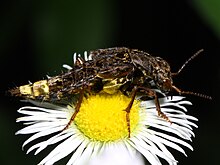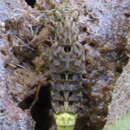Conservation Status
provided by University of Alberta Museums
Abundant.
- license
- cc-by-nc
- copyright
- University of Alberta Museums
Cyclicity
provided by University of Alberta Museums
More abundant in early spring but active throughout summer and fall.
- license
- cc-by-nc
- copyright
- University of Alberta Museums
Distribution
provided by University of Alberta Museums
Widespread and common in eastern and northwestern North America.
- license
- cc-by-nc
- copyright
- University of Alberta Museums
General Description
provided by University of Alberta Museums
The head and thorax of the O. cingulatus larvae are dark brown-red and the abdomen is dirty-brown color (Voris, 1939). The mature larvae can reach 25mm long and 4mm wide. The adult size range is between 13-18 mm but can reach up to 21mm. The brown body of O.cingulatus is irregularly marked with spots of heavy dark pubescence (Downie and Arnett, 1996). The tip of the abdomen is densely covered with golden-yellowish pubescence which also covers the metasternum (Downie and Arnett, 1996). Like for the other species of the genus Ontholestes, the anterior angles of the prontum are extended and angular, quite pointed (Smetana and Davies, 2000). Most of the leg is reddish-brown with the femora darker and the apex and the lateral edge usually lighter but variable (Smetana and Davies, 2000). The tarsal formula is 5-5-5. The dark red antennae have 11 segments with the last obliquely notched.
- license
- cc-by-nc
- copyright
- University of Alberta Museums
Habitat
provided by University of Alberta Museums
Woodland area but also open field. Adults and larvae are found on carrion, dung and decaying organic material (Arnett and Thomas, 2000).
- license
- cc-by-nc
- copyright
- University of Alberta Museums
Life Cycle
provided by University of Alberta Museums
Two or three days before pupation, the larva forms a nest-like cavity in a substrate like dung or soil, encloses itself in it and pupates (Voris, 1939). The pupal period varies between 10 to 14 days (Voris, 1939). Males of the species O. cingulatus were shown to exhibit an adaptive mate-guarding behavior. The male O. cingulatus stays close to the female after copulation while she oviposits to avoid fertilization from other males (Alcock, 1991). If threatened, O.cingulatus will bring the tip of its abdomen in contact with the threat and release a chemical defense.
- license
- cc-by-nc
- copyright
- University of Alberta Museums
Trophic Strategy
provided by University of Alberta Museums
A predator of flies associated with dung and carrion but also attracted to other decaying organic matter such as fungi, fruits and vegetables.
- license
- cc-by-nc
- copyright
- University of Alberta Museums
Ontholestes cingulatus
provided by wikipedia EN
Ontholestes cingulatus, known generally as the gold-and-brown rove beetle or carrion beetle, is a species of large rove beetle in the family Staphylinidae.[1][2][3]

Gold-and-brown rove beetle,
Ontholestes cingulatus
References
- license
- cc-by-sa-3.0
- copyright
- Wikipedia authors and editors
Ontholestes cingulatus: Brief Summary
provided by wikipedia EN
Ontholestes cingulatus, known generally as the gold-and-brown rove beetle or carrion beetle, is a species of large rove beetle in the family Staphylinidae.

Gold-and-brown rove beetle, Ontholestes cingulatus
- license
- cc-by-sa-3.0
- copyright
- Wikipedia authors and editors


 Gold-and-brown rove beetle, Ontholestes cingulatus
Gold-and-brown rove beetle, Ontholestes cingulatus